Grain Variety Licensing Program
UC Patented Plant Varieties
Working together to advance and deploy UC-developed cultivars in diverse national and international markets.
Barley Varieties
UC-Capay
The UC-Capay Cultivar
Development and Description
UC-Capay is a two-row spring malting barley (Hordeum vulgare L.) selected from the cross among ‘29IB20’, ‘Orca’ and ‘ND22202’. These three genotypes were among the best two-rowed genotypes for malting quality and adaptation to California Central Valley growing conditions when evaluated at the inception of the two-rowed malting barley breeding program at UC Davis.
UC-Capay is a two-row malting barley without sterile lateral florets in the spike. It is also about 20 cm taller and 15 days earlier to heading compared to UC Tahoe.
Yield and Malting Quality
UC-Capay has outstanding malting quality. It is superior in that regard to UC Tahoe for all environments and years tested. It showed higher grain yield than UC Tahoe under rain fed conditions, but slightly lower under irrigated trials.
Disease Resistance
UC-Capay has excellent tolerance to CYDV/BYDV, Powdery Mildew and Stripe Rust (significantly better than UC Tahoe and Butta 12 for stripe rust).
Adaptation
UC-Capay performed well in all areas where it was tested in the Sacramento and San Joaquin Valleys. UC-Capay is especially well-suited to rain fed conditions where its yield stability is strongly advantageous. UC-Capay combines excellent malting quality, low grain protein (about 8 to 10% lower than other varieties), high yield potential, and resistance to the most common diseases in California, i.e. yellow dwarf virus and stripe rust.
Commercial Availability
Barley growers can obtain UC-Capay from commercial nurseries licensed by the University of California. See Licensed Nurseries List.
UC Tahoe
The UC Tahoe Cultivar
Development and Description
UC Tahoe is a two-row spring malting barley developed by the University of California and tested in Regional Yield Trials as experimental line UC1409, MP103 and MP103MQ.
UC Tahoe was selected from a mapping population developed to study Cereal Yellow Dwarf Virus (CYDV). This mapping population originated in the cross between Butta 12 and Madre Selva and it was advanced as single seed descend (SSD) without selection. UC Tahoe was one of the few lines identified after the genotyping/phenotyping of the mapping population carrying tolerance to CYDV, and it was further selected for its excellent malting quality and agronomic traits.
Yield and Malting Quality
UC Tahoe showed similar grain yield compared to the Oregon two-row malting variety Full Pint during 2014/15 and 2015/16 Regional Trials. UC Tahoe malting quality was outstanding, similar to the long-term standard quality checks.
Disease Resistance
UC Tahoe has excellent tolerance to CYDV/BYDV and Powdery Mildew, significantly better than Full Pint. It is moderately resistant to stripe rust.
Adaptation
UC Tahoe performs well in all areas where it has been tested in the Sacramento and San Joaquin Valleys; it combines high yield potential, resistance to the most common diseases in California, and excellent malting quality in rain-fed conditions or under irrigation.
Seed Availability
Foundation seed of UC Tahoe is distributed by the University of California Foundation Seed Program to licensed brokers and seed houses twice annually, fall and spring. Off-cycle requests are considered on a case-by-case basis.
Commercial Availability
Barley growers can obtain UC Tahoe from commercial nurseries licensed by the University of California. See Licensed Nurseries List.
Butta 12
The Butta 12 Cultivar
Development and Description
Butta 12 is the first malting barley (Hordeum vulgare L.) released by the University of California to have completed “plant-scale” malting evaluations and to be brewed successfully by scores of craft brewers.
Butta 12 is a two-rowed malting type with a spring growth habit and is intended for November–December sowing in the Central Valley of California. Data published previously (Hegarty et al., 2018) showed Butta 12 to have a comprehensive grain yield of 4,168 kg per ha; kernel weight of 48.3 mg per hundred kernels; plant height of 89.8 cm, days-to-heading from 1 March of 32.5 days (about 3 days earlier than UC Tahoe); lodging score of 4.04 on a scale of 1–8; and a leaf yellowing rating of 2.1 on a scale of 1–8 for yellow dwarf viruses.
Yield and Malting Quality
Butta 12 produces a grain yield similar to UC Tahoe and Full Pint. UC Tahoe and Butta 12 are similar for malting quality. Butta 12 malt is capable of producing a wide array of flavors. For distillers, Butta 12 has an advantage over many cultivars in that it is low in glycosidic nitrile.
Disease Resistance
Butta 12 has effective field resistance to five fungi and two viruses that would otherwise pose a threat to the cultivar in its California Central Valley target environment.
Adaptation
Butta 12 is the first two-rowed malting barley released in California to complete robust plant-scale floor malting evaluation and to be accepted by Central Valley and surrounding foothill growers, a commercial maltster, craft brewers, and distillers.
Commercial Availability
Barley growers in California can obtain Butta 12 from commercial nurseries licensed by the University of California. See Licensed Nurseries List.
Tamalpais
The Tamalpais Cultivar
Development and Description
‘Tamalpais’ is a naked grained (hulless) spring food/feed barley released by the California Agricultural Experiment Station in 2008. Tamalpais is adapted to the Central Valley and surrounding foothills with sowing in November through December.
Tamalpais barley was selected from the hybridization of the ICARDA/CIMMYT barley line Ataco/Achira//Higo (CMB 91A-1192-AL) with ‘UC960’ in 1997. A final head row was selected in the F5 by Lynn Gallagher, UC Davis barley breeder, and placed into a preliminary grain yield trial in 2002. In 2003 the selection was designated UC1134 and placed into California statewide grain yield trials for evaluation. Kernels are short (<8mm) and the aleurone is transparent (non-blue). In absence of the hull, the grain weight of Tamalpais at 39.3 mg/kernel was less than that observed for UC 933 (41.1 mg/kernel), UC 969 (41.1 mg/kernel), and Ishi (43.1 mg/kernel) in eight trials. Resistance to shattering is good and not significantly different from other UC cultivars. For time to heading Tamalpais was 7 days later than UC 969, one day later than UC 933 and two days earlier than Ishi. For days to maturity Tamalpais was six days later than UC 969 and one and one-half days earlier than Ishi but similar to UC 933. The only observations for heading time and maturity during four years were made at UC Davis. As a new specialty crop the grower may like to find a new market for his naked grained barley. Use in soups, rustic bread, pet food or as a bird feed (preferred over wheat by pigeons) are among the possibilities.
Adaptation
Tamalpais is not meant to replace ‘UC 933’ or ‘Ishi’, which are both hulled semidwarf spring barleys, but to supplement them, thereby giving growers greater choices depending on marketability or end use of a potentially new product. Plant height was measured in 26 environments. For stature Tamalpais averaged 28.8 inches but varied widely from 17 to 39 in height depending mostly upon available soil moisture. Stature for other varieties averaged as follows: UC 933 (30.2 in), UC 969 (31.8 in), and Ishi (30.5 in). Only UC 969 is not a semidwarf barley. In 13 trials where lodging occurred, Tamalpais was similar to UC 969 with about 4 to 14% lodging whereas UC 933 and Ishi had 15 to 29% lodging on average. Hence Tamalpais has good lodging resistance.
Pest and Disease Resistance
Resistances to common California barley diseases are generally good. In 14 trials where leaf yellowing was observed because of Barley yellow dwarf virus, no significant differences were found among the varieties Tamalpais, UC 933, UC 969 and Ishi. Leaf yellowing was minimal. Small amounts of stripe rust have been observed in the trials and on average differences among varieties were not significant. However the highest level of infection (worst case) was as follows: Tamalpais (3.3), UC 933 (1.7), UC 969 (4.3), and Ishi (2.3) on a 1 to 8 scale wherein 1=0 to 3%, 2=4 to 14%, 3=15 to 29%, and 4=30 to 49% coverage of the flag (highest) leaf. These infections may arrive late in the growing season and may not cause a reduction in grain yield.
However abundant stripe rust has been found on susceptible barleys and may very be serious if it arrives by late February and conditions are ideal for the spread of the disease. The resistance of these varieties in the past is not a guarantee of future results. So far the resistance has held up.
Scald levels were low on the four above cultivars over the last four years and no significant differences have been observed among them. The worst observation on Tamalpais was less than 4% coverage of the flag leaf in one of 26 trials. In 8 of 26 trials leaf rust was scored. In the worst infection scenario for leaf rust, the following scores were noted: Tamalpais (1.0), UC 933 (5.8), UC 969 (2.0), and Ishi (3.5). The same scale above was used as noted above with 5=50 to 69% coverage of the flag leaf.
Generally leaf rust arrives quite late in the growing season and little or no grain loss occurs. Tamalpais does demonstrate good resistance to leaf rust.
Powdery mildew was observed in only two of 26 trials and each time Tamalpais had less than 3% flag leaf coverage. There are not enough data to draw a conclusion about resistance to powdery mildew.
Yield Data
Tamalpais has been tested for grain yield over the last four years through the 2007 harvest. Grain yield over 26 trials averaged 4,022 lb/acre which was less than ‘Ishi’ having 4,328 lb/ac and UC933 having 4,194 lb/ac but more than UC969 having 3,852 lb/ac. No adjustment was made for the loss of hulls, which may account for about 12.5% of total weight, in these measurements. Tamalpais hulless barley does not thresh as well as wheat and small or “pinched” grains may not thresh at all, but appropriately cleaned, plump grain should thresh well above 90% free. As a result of nakedness Tamalpais has a very high test weight for barley. Over 23 environments Tamalpais averaged 55.2 lb/bu compared to the following hulled barleys: UC969 (52.2 lb/bu), Ishi (49.8 lb/bu), and UC933 (49.6 lb/bu).
Commercial Availability
Barley growers in California can obtain Tamalpais from commercial nurseries licensed by the University of California. See Licensed Nurseries List.
UC Schaller
The UC Schaller Cultivar
Development

‘UC-Schaller’ is a spring six row hooded barley developed for use in forage mixtures or as a dual purpose (forage/grain) barley developed by Dr. Lynn Gallagher at UC Davis and released in 2020. It is adapted to the Central Valley and San Joaquin Valley.
Breeding History and description
The pedigree of UC-Schaller is K215//Sara/Tango. K215 was an elite spring 6 row hooded forage line derived from the cross that included Hooded Atlas, which was developed by Dr. C. W. Schaller, former UC Davis barley breeder. The Sara/Tango cross was obtained from Oregon State University (OSU). Joey Gonsalves of Stanislaus Farm Supply selected several sister lines to test in collaboration with Oly Cantu of Arizona Plant Breeders. Schaller was tested in regional grain trials in 2013 as UC1355 along with its sister lines. UC-Schaller was selected by Mr. Gonzales was for its resistance to BYDV over several seasons. It continued to tested in the regional trials in 2014 and 2016. It was also tested in forage trials in Davis in 2017 and 2018 by Dr. Cal Qualset. It is on average 5.5 in. taller and heads 9.8 days later than UC 933.
Adaptation
As a hooded barley, Schaller does not have awns that can be harmful to grazing animals. The later maturity of Schaller makes it better suited for forage and for mixtures with later maturing oat and wheat.
Pest and Disease
Schaller is more resistant to Barley Yellow Dwarf Virus (BYDV) and barley stripe rust (BSR) than Ishi, Max, UC603 and UC933. It is moderately susceptible to scald. It is also moderately susceptible to Shark herbicide at early growth stages.
Yield data
In forage trials, Schaller produced similar biomass, matured later, was taller, and had less lodging than UC933 barley. Schaller is similar in grain yield to UC six row awned barley varieties Max, Tamalpais, UC603, but lower than Ishi, UC 933, and UC1280 (UC Tehama). Schaller is among the tallest and latest maturing barley varieties but less susceptible to lodging than Ishi and UC1280 (UC Tehama).
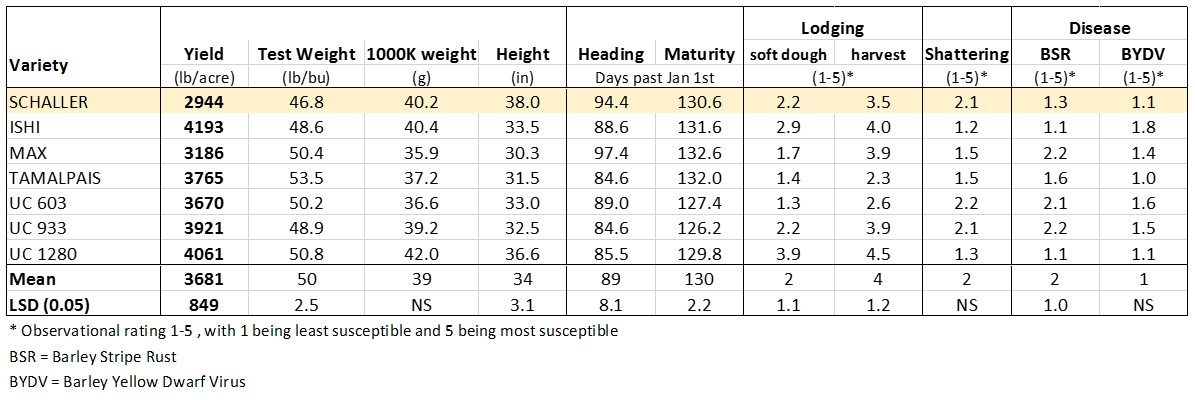
Commercial Availability
Barley growers in California can obtain UC Schaller from commercial nurseries licensed by the University of California. See Licensed Nurseries List.
Triticale Varieties
UC Bopak
The UC Bopak Cultivar
CULTIVAR DESCRIPTION
UC-Bopak is a triticale intended for the production of feed grain and silage with exceptionally high yield and good tolerance to lodging and disease resistance. UC-Bopak was selected for plants with a shorter stature, minimal lodging and high grain yield under high input conditions.
CHARACTERISTICS
UC-Bopak is a medium height triticale, which stands approximately 7.5 inches taller and heads out 4 days earlier than the widely used cultivar 158EP. UC-Bopak produces and exceptional grain yield, averaging 8.3% higher than 158EP across the 14 sites tested. Compared with UC-Atrea, UC-Bopak is 3 inches taller, heads 2 days later, has slightly greater yield potential, but slightly more susceptibility to lodging.
DISEASE RESISTANCE
UC-Bopak has shown good levels of resistance to all major pathogens including stripe rust, septoria and yellow dwarf rust.
AREA OF ADAPTATION AND PRIMARY USE
UC-Bopak has performed very well in all locations throughout the Central Valley of California, delivering high yields even when under drought and nutrient stress. This fully awned cultivar is intended for the production of feed grain and silage.
Commercial Availability
Producers can obtain UC Bopak from commercial nurseries licensed by the University of California. See Licensed Nurseries List.
UC Atrea
The UC Atrea Cultivar
CULTIVAR DESCRIPTION
UC-Atrea is a triticale intended for the production of feed grain and silage with exceptional yield and good tolerance to lodging and disease resistance. UC-Atrea was selected for a shorter stature, minimal lodging and high grain yield under high input conditions.
CHARACTERISTICS
UC-Atrea is a medium height triticale, which stands approximately 5 inches taller and heads out 6 days earlier than the widely used cultivar 158EP. UC-Atrea produces an exceptional grain yield, averaging 5.5% higher than 158EP across the 26 sites tested. Compared with UC-Bopak, UC-Atrea is 3 inches shorter, heads 2 days earlier and has slightly better standibility in highly fertile locations.
DISEASE RESISTANCE
UC-Atrea has shown good levels of resistance to all major pathogens including stripe rust, septoria and yellow dwarf virus.
AREA OF ADAPTATION AND PRIMARY USE
UC-Atrea has performed very will in all locations throughout the Central Valley of California, delivering high yields even when under drought and nutrient stress. This fully awned cultivar is intended for the production of feed grain and silage.
Commercial Availability
Producers can obtain UC Bopak from commercial nurseries licensed by the University of California. See Licensed Nurseries List.
Wheat Varieties
Clear White
The Clear White Cultivar
Clear White is a hard white spring wheat that was selected for its good grain potential, resistance to stripe rust, leaf rust and its excellent breadmaking and Asian noodle quality.
Clear White has an erect growth habit with recurved flag leaf. It has middense white spikes with long awns (9–11 mm). The glumes are large, wide, and acuminated with a rounded shoulder. The kernel is oval, white, with a long brush.
Commercial Availability
Growers can obtain Clear White from commercial nurseries licensed by the University of California. See Licensed Nurseries List.
Desert King
The Desert King Cultivar
DEVELOPMENT
Desert King was developed by the University of California wheat breeding program lead by Dr. Jorge Dubcovsky and research associates Oswaldo Chicaiza and Lee Jackson. Selection for disease and pest resistance, yield, was conducted at the UC Desert Research and Extension Center and in grower’s fields in the San Joaquin and Sacramento Valley. Pasta quality was evaluated at the California Wheat Commission. Funding for this project came from the University of California, the California Wheat Commission and the California Crop Improvement Association.
BREEDING HISTORY & DESCRIPTION
Desert King is a short-stature spring durum variety with erect leaves and excellent lodging resistance. The original material was received from CIMMYT as line CD96235 in 1997. Selections of rows with good agronomic traits and disease resistance were made at Tulelake in Sept of 1998. One row was selected and advanced into a Preliminary and Advanced yield trials at Imperial Valley in 1999 and 2000 respectively. A pure seed increase at Tulelake was used to set up Elite yield trials at Imperial Valley and San Joaquin Valley in 2001. This line was tested as UC1375 in Elite and Regional Trials in 2002, 2003 and 2004. During the three years of testing Desert King showed high yield potential and good pasta quality. Breeder seed was produced at UC Davis during the 2002-2003 growing season. Foundation seed was harvested at Imperial Valley in 2004.
ADAPTATION
Desert King was tested from 2002 to 2004 under irrigation in the Imperial, San Joaquin, and Sacramento valleys, and in 2004 in Arizona. During the three years of testing Desert King was among the highest yielding varieties in all the environments, indicating a wide adaptability and good yield stability. Desert King represents a significant yield increase over the current dominant variety Kronos and maintains the high quality standard required for the Desert Durum class.
PEST & DISEASE RESISTANCE
In the 2002 and 2003 filed tests at Davis, Kings, Kern, Madera and Imperial Valley, Desert King was resistant to the current races of leaf rust, stripe rust, black point, Barley Yellow dwarf virus. Artificial inoculation tests at the Disease Laboratory in Minnesota showed moderate size pustules without chlorosis or necrosis when tested with leaf rust Mexican race MX15-1 and with European leaf rust races F2-1 and ESP16.
AVERAGE YIELD DATA 2002-2004
Considering the average of the last three years of trials in CA and one year in AZ, Desert King has shown significant higher yields than the dominant variety Kronos in the Imperial Valley (540-lbs higher), the San Joaquin Valley, (1280-lbs higher), and Arizona (331-lbs higher).

Commercial Availability
Growers can obtain Desert King from commercial nurseries licensed by the University of California. See Licensed Nurseries List.
Patwin
The Patwin Cultivar
BREEDING HISTORY & DESCRIPTION
Patwin (experimental line UC1419) is a Hard White Spring derived from the cross Madsen/2*Express.
Patwin is a short stature wheat variety with similar height as Blanca Grande (~35 inches in Davis) and early heading time ~10 days later than Blanca Grande.
Wax is abundant on the surfaces of leaves, glumes, stems and peduncles in mature Patwin plants (Figure 1).
ADAPTATION
Patwin performs well agronomically in all areas where it has been evaluated in California and has good quality characteristics for bread making. Patwin appears to be well suited for the San Joaquin, Sacramento, and Imperial Valley where it shows high yield potential under irrigation. Patwin combines a high yield potential with excellent bread making quality and resistance to the major pathogens found in California. Its primary use is for bread production.
PEST & DISEASE RESISTANCE
Patwin is resistant to current field races of stripe rust present in California. Patwin also has the lowest levels of flag leaf infection with septoria tritici blotch among the hard white wheats (see comparison with Blanca Grande and Clear White in Figure 3). Patwin has been identified to have resistance to root-knot nematodes in potted studies but the economic benefit to subsequent susceptible crops in the rotation is unclear.
Comparison between Patwin (resistant) and Blanca Grande & Clear White (susceptible) for leaf damage produced by stripe rust and Septoria Tritici Blotch, Davis May 2006.
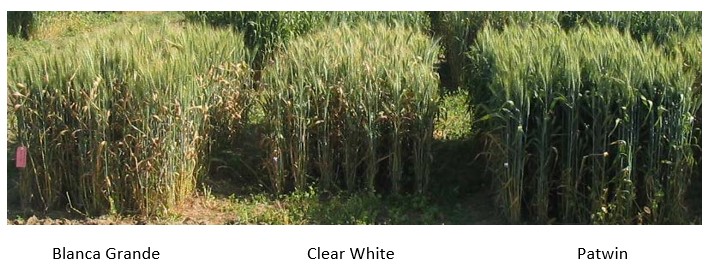
AVERAGE YIELD DATA
Patwin showed the highest yields in the San Joaquin Valley (9 locations) and the 4th highest yield in the Sacramento Valley (8 locations, Figure 2) Small Grains Regional Trials (averages 2008-2010). It was also the 3rd highest yielding released variety in the Imperial Valley. Because of its high yield potential in all three valleys, Patwin is recommended for all three regions.
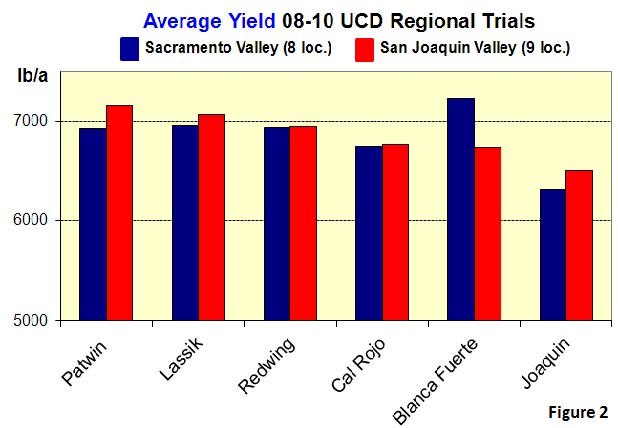
BREADMAKING QUALITY
Patwin has very high levels of grain protein content (13.5±0.3 % protein) higher than those observed in Lassik, Redwing, Cal Rojo, Blanca Fuerte or Joaquin (Figure 4). Protein levels are similar to those observed in the new high grain protein variety Blanca Grande 515. Patwin has a hard grain texture (similar to the old variety Express), high water absorption, and strong gluten that result in optimum breadmaking quality. Patwin shows high falling numbers, even when cool springs induce low falling numbers in other varieties, such as Expresso, Summit 515, Blanca Grande 515 and others.
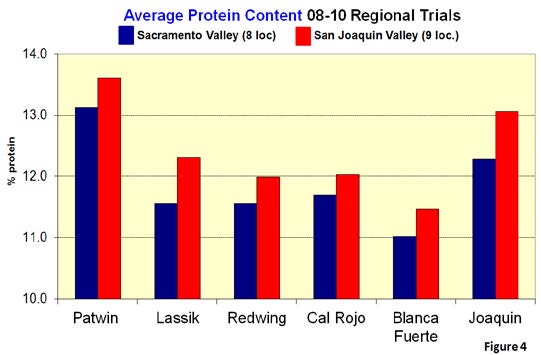
Commercial Availability
Growers can obtain Patwin from commercial nurseries licensed by the University of California. See Licensed Nurseries List.
Lassik
The Lassik Cultivar
ORIGIN AND DESCRIPTION OF THE VARIETY
Lassik “UC1495” is a Hard Red Spring (HRS) derived from Anza. Lassik has similar height, flowering time, and spike characteristics as Anza.
DISEASE RESISTANCE
Lassik is resistant to current races of stripe rust (Fig.1, Table 1). It has three different stripe rust resistance genes (Yr17, Yr18 and Yr36).
Lassik also has two genes for leaf rust resistance (Lr34 and Lr37) and good levels of resistance to septoria tritici blotch and to barley yellow dwarf virus.
Lassik has been identified to have resistance to root knot-nematodes in potted studies but the economic benefit to subsequent susceptible crops in the rotation is unclear.
Figure 1. Lassik showed improved resistance to strip rust in the field compared to Anza.
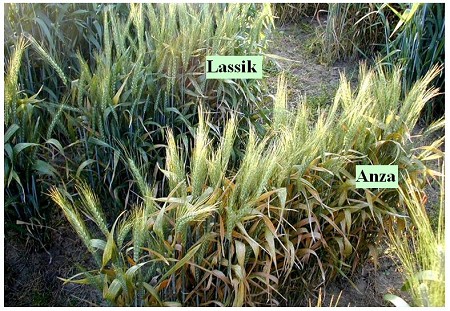
YIELD POTENTIAL
Lassik showed significantly higher yields than Anza in 2006 and 2007. Differences were particularly clear at locations with high levels of stripe rust infection, suggesting that the increased yield is related to Lassik improved stripe rust resistance.
BREADMAKING QUALITY
Lassik has significantly higher grain protein content than Anza (13.6% vs. 12.2%) and stronger gluten than Anza, as a result of the incorporation of the high grain protein content gene Gpc-B1. This protein increase results in longer mixing time (109% longer), longer departure time (98% longer), and larger loaf volume (16% larger) (Table 2). Lassik samples tested by ADM – wheat; Bay State Milling; Horizon Milling/Cargill – wheat; Cereal Food Processors, Inc., and the California Wheat Commission quality laboratory, showed good breadmaking characteristics.
Table 2. Comparison between Anza and Lassik breadmaking quality. Data from 4 locations and two blocks per location. Numbers in red are significantly higher.

Commercial Availability
Growers can obtain Lassik from commercial nurseries licensed by the University of California. See Licensed Nurseries List.
Desert King - High Protein
The Desert King – High Protein Cultivar
DEVELOPMENT
Desert King was developed at the University of California wheat breeding program by wheat breeders Dr. Jorge Dubcovsky and Oswaldo Chicaiza and lab assistant Xiaoqin Zhang. ‘Desert King-High Protein’(henceforth, DK-HP) showed a significantly higher grain protein concentration than the original variety ‘Desert King’ (8 to 10% increase) and improved pasta quality parameters as determined at the California Wheat Commission Quality Laboratory. Funding for this project came from the University of California Discovery grant, the California Wheat Commission and the California Crop Improvement Association.
BREEDING HISTORY & DESCRIPTION
Desert King-High Protein is a short-stature spring durum variety with erect leaves and excellent lodging resistance. This variety was developed by five backcrosses of the high grain protein content gene Gpc-B1 from wild wheat into Desert King followed by agronomic selection. The original Desert King is a widely grown Desert Durum variety developed by the University of California Wheat Breeding program. It has very high yield potential, low black tip incidence, and excellent pasta quality. The Gpc-B1 gene present in wild wheat is functional whereas the form present in Desert King and other commercial durum cultivars is not functional. The replacement of the non-functional copy by the functional one, increases grain protein content by approximately 10% and accelerates grain maturity 5-8 days. The Gpc-B1 gene, discovered at Dr. J Dubcovsky laboratory in 2006 (Science 2006, 314:1298-1300), is very close to an additional gene for stripe rust resistance designated Yr36. The two genes were transferred together using molecular markers flanking both genes, increasing grain protein content and stripe rust resistance in DK-HP simultaneously.
ADAPTATION
DK-HP was tested in the Durum Wheat Elite Trials in 2008 and 2009 and in Regional Trials in 2009 and 2010 under the UC identification number UC1627. DK-HP combines a high yield potential, good pasta quality, and resistance to the major wheat pathogens found in California. Its primary use is for pasta production. DK-HP performs well agronomically in all areas where it has been evaluated in California. DK-HP is well suited for the San Joaquin and Imperial Valley, the main durum producing areas in California, but has also the potential to expand the durum growing area in California to the Sacramento Valley, an area were previous varieties were unable to reach the high grain protein content levels required for high-quality pasta varieties.
PEST & DISEASE RESISTANCE
DK-HP was resistant to the current races of leaf rust, stripe rust, black point, barley yellow dwarf virus.
AVERAGE YIELD DATA
The faster maturity of DK-HP has the potential to accelerate harvesting 5 to 8 days relative to Desert King but also results in a shorter grain filling period and an average yield reduction of 3-4% relative to Desert King (based on 5 field trials). This slight reduction in yield is compensated by an 8-10% increase in grain protein content, resulting in a net increase in total harvested Nitrogen (Table 1). Therefore, DKHP is preferred to Desert King when higher levels of grain protein are desired, for use in blends to rich grain protein targets, or to grow high quality durum in the Sacramento Valley. Often there is a graph or table here.

Commercial Availability
Growers can obtain Desert King – High Protein from commercial nurseries licensed by the University of California. See Licensed Nurseries List.
Patwin 515
The Patwin 515 Cultivar
DEVELOPMENT
Patwin-515 is a hard white spring hexaploid wheat variety derived from the UC variety Patwin (currently grown in 7000 ac in the Sacramento Valley). Patwin is resistant to current races of stripe rust present in California and carries the stripe rust resistance gene Yr17 and other unknown stripe rust resistance genes. As part of a preventive breeding effort to improve the durability of the stripe rust resistance varieties, stripe rust resistance genes Yr5 and Yr15 were introgressed into Patwin. The population of stripe rust races in California is continuously changing and the pyramiding of multiple resistance genes is required to enhance durability. Resistance genes Yr5 and Yr15 are currently resistant to all known races of P. striiformis present in California and elsewhere in the United States, and were introgressed into Patwin using two independent backcross programs.
Patwin-515 flowers earlier (4-5 days) than Patwin and is 8 cm shorter than Patwin. Patwin is resistant to stripe rust, so the incorporation of Yr5 and Yr15 is intended to protect those resistance genes and extends durability of the resistance. Patwin-515 also showed significantly better levels of resistance to barley yellow dwarf virus (BYDV) than Patwin. Patwin and Patwin-515 are morphologically very similar and show similar yield potential (Patwin-515 yield was 330 kg/ha higher than Patwin). Patwin and Patwin-515 have excellent bread-making quality.
YIELD POTENTIAL
Patwin-515 performs well agronomically in all areas where it has been evaluated in California and has good quality characteristics for bread making. Patwin-515 appears to be very well suited for the Sacramento, San Joaquin and Imperial Valleys where it shows high yield potential under irrigation. Patwin-515 combines high yield potential with excellent bread making quality and resistance to the major pathogens found in California. Its primary use is for bread production. The figures shows comparative yields of Patwin 515 to other high-yielding strip rust resistant California varieties (average 2011-2012 regional trials) in the Sacramento and San Joaquin Valleys.
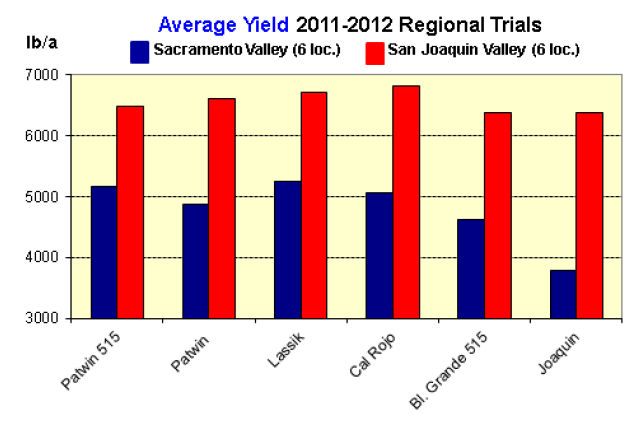
Commercial Availability
Growers can obtain Patwin 515 from commercial nurseries licensed by the University of California. See Licensed Nurseries List.
Miwok
The Miwok Cultivar
DEVELOPMENT
A low-cadmium desert durum: Cadmium is a heavy metal that may have negative impacts on human health if consumed at high levels for long periods of time. Therefore, some import markets such as the European Union are requesting lower levels of cadmium in the food. Most commercial durum varieties have relatively high levels of cadmium in the grain when planted in soils with high levels of this heavy metal. To improve consumer safety and avoid the exclusion of California durum wheat varieties from international export markets we are developing low cadmium durum varieties for California.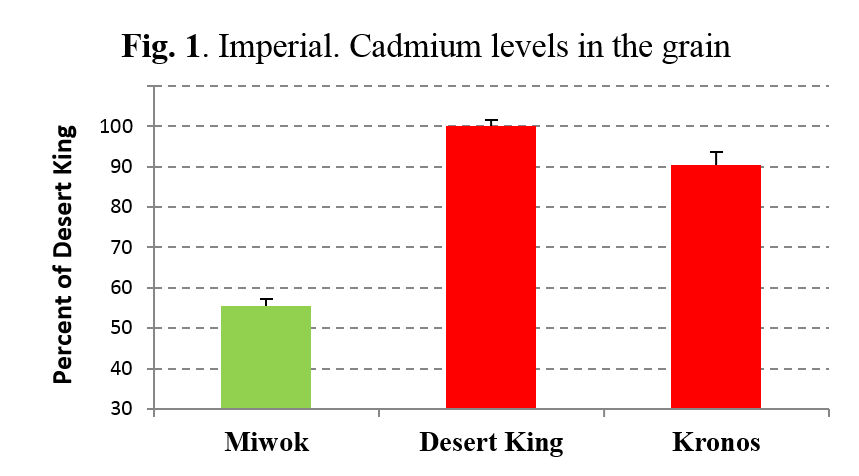
The high level of cadmium in durum wheat is associated with a defective Cdu1 gene. The incorporation of the functional Cdu1 (from the variety Strongfield) greatly reduces the levels of cadmium in the grain. “Miwok’, is the first UC Davis variety with a functional Cdu1 gene, which is reflected in cadmium levels that are 44% lower than those observed in Desert King and 38% lower than those observed in Kronos (Fig. 1).
YIELD POTENTIAL
In the 2013-2015 Regional Trials at Imperial and San Joaquin valleys Miwok showed excellent yield potential (Fig.2). At Imperial Valley, Miwok average yield was the second highest and in the San Joaquin Valley the fourth highest.
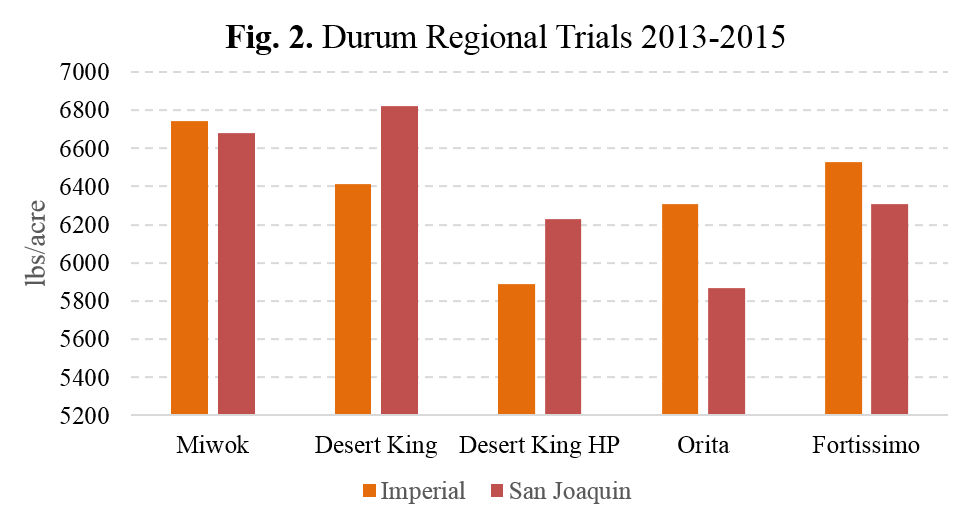
QUALITY
Quality parameters were obtained from analyses conducted at the California Wheat Commission quality laboratory from 2011-2013 (http://smallgrains.ucdavis.edu/) and from the California Wheat Quality Collaborator Program in 2011-2012. In all these trials Miwok showed excellent values for all pasta quality: high protein content (~Kronos), strong gluten and excellent pasta color (similar to Desert King). Miwok showed higher semolina extraction than other durum varieties
Commercial Availability
Growers can obtain Miwok from commercial nurseries licensed by the University of California. See Licensed Nurseries List.
Yurok
The Yurok Cultivar
DEVELOPMENT
Yurok is a Hard Red Spring hexaploid wheat variety developed from the cross UC1110 / UC1037 Gpc-B1-Glu-D1d, 2NS_trans. The variety was developed by the University of California wheat breeding program and was tested in Regional Yield trials as experimental line UC1745 (http://smallgrains.ucdavis.edu/).
CHARACTERISTICS
Yurok is semidwarf variety (~40 inches) with an intermediate heading time similar to Summit-515. Yurok grain yield is similar to Summit-515 and higher than Joaquin Oro and Cal Rojo (2014-2016).
DISEASE RESISTANCE
Yurok is resistant to all current races of stripe rust present in California and shows good tolerance for BYDV and septoria.
QUALITY
Yurok showed excellent bread making quality in evaluations performed by the quality Laboratory at the California Wheat Commission and by the milling industry at the California Wheat Collaborator Program (2013 and 2014). Yurok carries the GPC-B1 gene for high grain protein content, and shows protein contents similar to Cal Rojo and Summit 515, but lower than Joaquin Oro. The molecular marker for the GPC-B1 gene can be used to distinguish Yurok from most current commercial CA varieties.
AREA OF ADAPTATION AND PRIMARY USE
Yurok performs well agronomically in all areas where it has been evaluated in California and has good quality characteristics for bread making. Yurok appears to be very well suited for the Sacramento, San Joaquin and Imperial Valleys where it shows high yield potential under irrigation. In all these regions Yurok showed excellent bread making quality and resistance to the major pathogens found in California. Its primary use is for bread production.
Commercial Availability
Growers can obtain Yurok from commercial nurseries licensed by the University of California. See Licensed Nurseries List.
Patwin 515 - High Protein
The Patwin 515 – High Protein Cultivar
DEVELOPMENT
Patwin-515HP is a Hard White Spring hexaploid wheat variety developed by the University of California wheat breeding program and tested in Regional Yield trials as experimental line UC1743.
YIELD
Patwin-515HP is a semidwarf variety with an intermediate heading time similar to Patwin and Blanca Grande-515. In the 2016 Regional Trials, Patwin-515HP grain yield was higher than Blanca Grande-515 in the Sacramento Valley (~15%) and similar in the San Joaquin valley (Fig. 1). The average yield of Patwin-515-HP across 15 experiments was slightly higher (126 lbs/ac) than the original Patwin-515 (but not significantly).
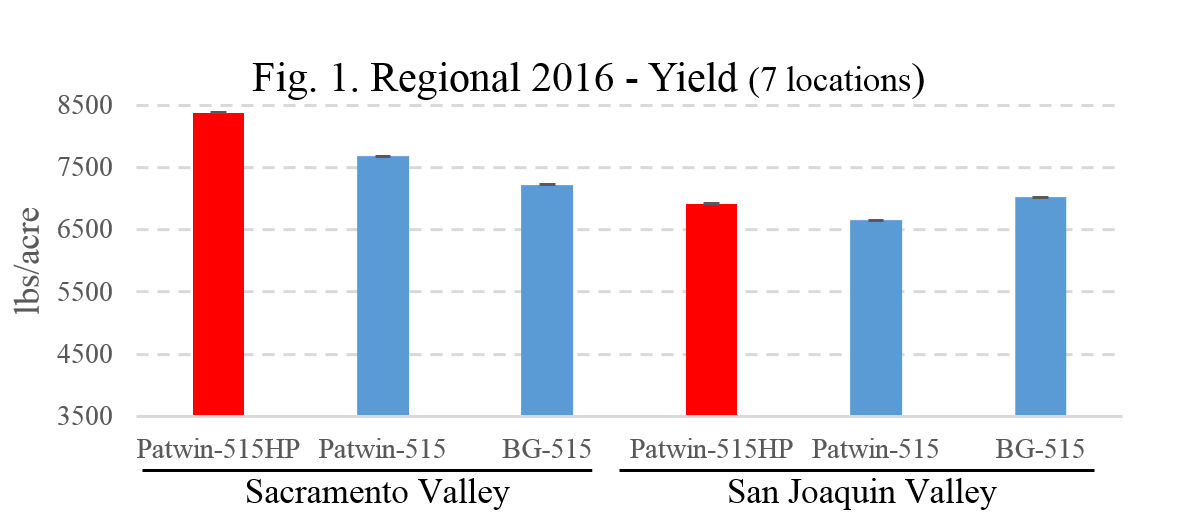
QUALITY
Patwin-515HP showed outstanding bread making quality in evaluations performed by the quality Laboratory at the California Wheat Commission in 2013 and 2016 and by the milling industry at the California Wheat Collaborator Program in 2013. Patwin-515HP carries the GPC-B1 gene for high grain protein content. Across 15 experiments, it showed an average grain protein content of 13.8%, which was significantly higher than the original Patwin-515 (12.7%), which does not carry the GPC-B1 high grain protein gene (Fig.2).
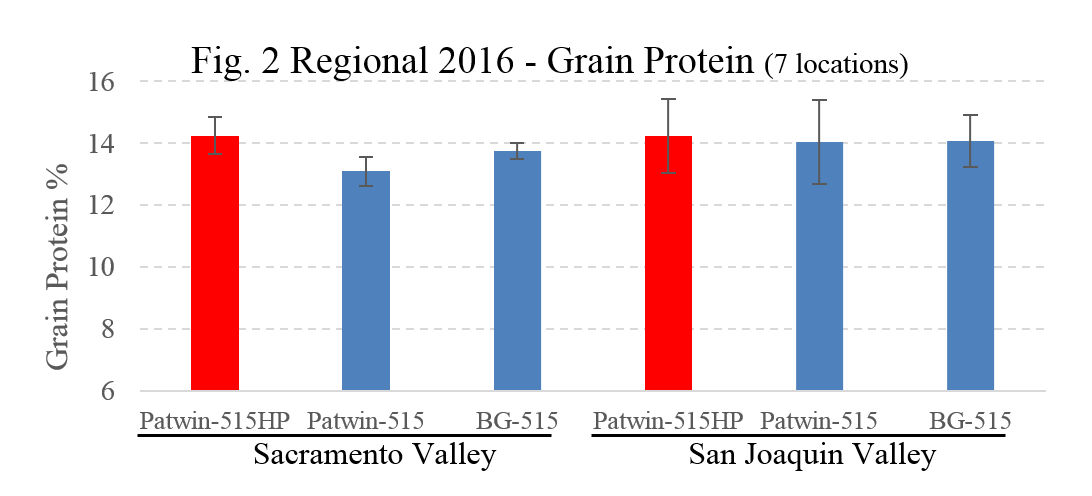
DISEASE RESISTANCE
Patwin-515HP is resistant to all current races of stripe rust present in California and shows good tolerance for BYDV and septoria tritici blotch. It shows higher resistance to septoria tritici blotch than Blanca Grande-515. Patwin-515HP carries rust resistance genes Yr5, Yr15, and Yr36 that are effective against all current races of stripe rust in California.
AREA OF ADAPTATION AND PRIMARY USE
Patwin-515HP is very well suited for the Sacramento, San Joaquin and Imperial Valleys where it shows high yield potential under irrigation. Its primary use is for bread production.
Commercial Availability
Growers can obtain Patwin 515 – High Protein from commercial nurseries licensed by the University of California. See Licensed Nurseries List.
UC-Desert Gold
The UC-Desert Gold Cultivar
DEVELOPMENT
UC-Desert Gold is a durum wheat variety developed by the introgression of two genes for improved yellow pigment and one gene for reduced grain cadmium content in the UC Davis wheat variety Desert King. This variety was developed by the University of California wheat-breeding program and was tested in Regional Yield trials as experimental line UC1850.
CHARACTERISTICS
UC-Desert Gold is very similar in yield, heading time and plant height to the successful variety Desert King. UC-Desert Gold has significantly better pasta color, gluten strength and reduced cadmium content in the grain (a beneficial health trait) than Desert King.
QUALITY
UC-Desert Gold represents an improvement in pasta quality relative to Desert King. It has better semolina and pasta color (see figure) and higher gluten strength. UC-Desert Gold received excellent quality evaluations by the milling industry at the California Wheat Quality Collaborator Program in 2017.
NUTRITIONAL CHARACTERISTICS
UC-Desert Gold carries the Cdu1 gene, which reduces its grain cadmium levels to less than half of the levels observed in durum varieties without this gene (e.g. Desert King, Orita and Fortissimo). Low cadmium levels are beneficial for human health.
AREA OF ADAPTATION AND PRIMARY USE
UC-Desert Gold performed very well in the South San Joaquin and Imperial Valleys where it showed high yield potential under irrigation and good resistance to diseases. UC-Desert Gold primary use is for pasta.
Commercial Availability
Growers can obtain UC Desert Gold from commercial nurseries licensed by the University of California. See Licensed Nurseries List.
UC-Central Red
The UC-Central Red Cultivar
DEVELOPMENT
UC-Central Red is a Hard Red Spring bread wheat variety developed from the cross UC1107(Yr15, Glu-D1d, 2NS/2AS)/Expresso. This variety was developed by the University of California wheat-breeding program and was tested in Regional Yield trials as experimental line UC1817 (http://smallgrains.ucdavis.edu/).
CHARACTERISTICS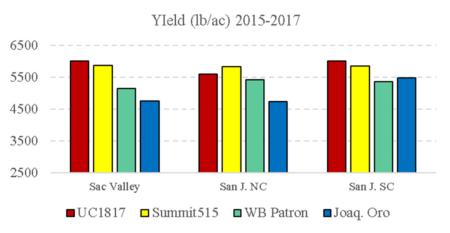
UC-Central Red is a semidwarf variety 3 inches shorter and 4 days earlier than Yurok. Its grain yield is similar to Summit515 and higher than WB Patron and Joaquin Oro (see UC1817 in figure for 2015-2017 Regional Trials).
DISEASE RESISTANCE
UC-Central Red is resistant to all current races of stripe rust present in California and shows good tolerance for BYDV and septoria tritici.
QUALITY
UC-Central Red has the best bread making and tortilla quality among the current UC HRS varieties. It received excellent quality evaluations by the milling industry at the California Wheat Collaborator Program in 2018. It has higher grain protein content than Yurok, Summit 515 and Cal Rojo.
AREA OF ADAPTATION AND PRIMARY USE
UC-Central Red performed very well agronomically in the Sacramento, San Joaquin and Imperial Valleys where it showed high yield potential under irrigation and good resistance to all major diseases. This variety stands out for its excellent breadmaking and tortilla quality, which are the main intended uses of this variety.
Commercial Availability
Growers can obtain UC Central Red from commercial nurseries licensed by the University of California. See Licensed Nurseries List.
UC-Amarillo
The UC-Amarillo Cultivar
CULTIVAR DESCRIPTION
UC-Amarillo is the first Hard White Spring bread wheat variety with yellow flour. The genes required for the synthesis of the yellow carotenoid pigments of the grain are broken in commercial wheat varieties due to years of selection for white flour. We restored the functional genes for yellow pigment which included lutein and zeaxanthin. These pigments are present in the human eye and have been associated with positive health benefits.
DEVELOPMENT
UC-Amarillo was developed by introducing multiple beneficial genes in the hard white line UC1107 using marker assisted selection: 1 gene for strong gluten, 4 genes for resistance to strip rust, 2 genes for resistance to leaf rust, 1 gene for high grain protein content and the functional PSY1 gene to restore the synthesis of yellow pigments.
CHARACTERISTICS
UC-Amarillo is a semidwarf variety(~38 inches) that flowers two days later than Patwin-515. Its grain yield is similar to WB Joaquin Oro and Yecora Rojo, and it has a high grain protein content similar to Bianca Grande.
GROWING REGIONS
UC-Amarillo performs very well agronomically under irrigation in the Sacramento, San Joaquin and Imperial Valleys. It stands out for its excellent breadmaking quality and its unique yellow flour, which might be of interest for artisan bakers.
DISEASE RESISTANCE
UC-Amarillo is resistant to all current races of stripe rust present in California and shows good tolerance for septoria tritici and leaf rust.
BREADMAKING QUALITY
UC-Amarillo has high protein, strong gluten and an exceptional dough mixing stability that contributes to its excellent breadmaking quality. It received excellent quality evaluations by the milling industry at the Collaborator Program.
Growers can obtain UC-Amarillo from commercial nurseries licensed by the University of California. See Licensed Nurseries List.
Yecora Rojo 515
The Yecora Rojo 515 Cultivar
CULTIVAR DESCRIPTION
Yecora Rojo-515 is a semidwarf, early heading Hard Red Spring (HRS) similar to Yecora Rojo but with improved resistance to stripe rust. Yecora Rojo-515 was tested for grain yield and breadmaking quality and showed similar yield and quality to the original variety. Yecora Rojo-515 is 5cm shorter than Yecora Rojo but other than that is identical to the original variety. However, in regions where stripe rust was present, Yecora Rojo was infected and suffered large yield losses whereas Yecora Rojo-515 was immune to the disease and did not suffer any yield penalty.
DEVELOPMENT
Yecora Rojo-515 was developed by backcrossing the stripe rust resistance genes Yr5 and Yr15 that are effective against all current races present in California using marker assisted selection. Since the two genes were backcrossed six times using the old Yecora Rojo as recurrent parents, Yecora Rojo-515 is expected to be approximately 99% identical to the old Yecora Rojo, except for the two new resistance genes.
DISEASE RESISITANCE
Yecora Rojo-515 was shown to be immune to the highly virulent Puccinia striformis races PSTv-4, PSTv-37, PSTv-40, PST-v41 and PSTv-22, for which the old Yecora Rojo was highly susceptible. Field tests confirmed the resistance of Yecora Rojo-515 and the susceptibility of Yecora Rojo to this disease.
AREA OF ADAPTATION
Yecora Rojo-515 yield performance is similar to that of Yecora Rojo in all regions of California where the old variety is currently grown. Its primary use is for bread production.
BREADMAKING QUALITY
Yecora Rojo-515 quality tests at the California Wheat Commission showed the same excellent breadmaking quality as Yecora Rojo, which has been a standard for breadmaking quality in California for more than 40 years.
Commercial Availability
Growers can obtain Yecora Rojo 515 from commercial nurseries licensed by the University of California. See Licensed Nurseries List.
Licensed Nurseries
Below are the current licensed nurseries and distributors in agreement with the University of California. You must obtain a license agreement if you would like to propagate and/or transfer UC varieties.
Barley Varieties
Adams Grain Company
Barley Varieties: UC-Alameda
Contact Information: 530-668-2000, [email protected], https://www.adamsgrp.com/
7301 John Galt Way, Arbuckle, CA 95912
Adam’s Seed, Inc.
Barley Varieties: UC Capay
Contact Information: 530-668-2000, [email protected], https://www.adamsgrp.com/
7301 John Galt Way, Arbuckle, CA 95912
Triticale Varieties
Second Nature Research, LLC
Triticale Varieties: UC-Atrea
Contact Information: 928-217-3132, [email protected]
PO Box 5540, Yuma, Arizona 85366
Bob & Joe Baglietto Seed Company
Triticale Varieties: UC-Bopak
Contact Information: 209-466-0433, https://www.bagliettoseeds.com/
301 S Aurora St, Stockton, CA 95203
Wheat Varieties
Adams Grain Company
Wheat Varieties: UC-Central White
Contact Information: 530-668-2000, [email protected], https://www.adamsgrp.com/
7301 John Galt Way, Arbuckle, CA 95912
Adam’s Seed, Inc.
Wheat Varieties: Patwin 515, Patwin-515 HP, Yecora Rojo-515, Yurok
Contact Information: 530-668-2000, [email protected], https://www.adamsgrp.com/
7301 John Galt Way, Arbuckle, CA 95912
All Star Seed
Wheat Varieties: Desert King
Contact Information: 760-482-9420
2015 Silsbee Road, El Centro, CA 92243
Baglietto Seeds
Wheat Varieties: Desert King HP
Contact Information: 209-466-0433, https://www.bagliettoseeds.com/
301 S Aurora St, Stockton, CA 95203
Bob & Joe Baglietto Seed Company
Wheat Varieties: Lassik
Contact Information: 209-466-0433, https://www.bagliettoseeds.com/
301 S Aurora St, Stockton, CA 95203
Farmers Grain Elevator
Wheat Varieties: Desert King HP
Contact Information: 530-662-9626, https://farmersgrainelevator.com/
PO Box 220, Yolo, CA 95697
Imperial Valley Milling Company
Wheat Varieties: Tipai
Contact Information: 760-356-2914, [email protected], https://imperialvalleymilling.com/
250 East 5th Street, Holtville, CA 92250
Limagrain Cereal Seeds LLC
Wheat Varieties: UC-Lassik-RS, UC-Patwin-RS, UC-Desert King-RS
Contact Information: 970-478-2200, https://limagraincerealseeds.com/
2040 SE Frontage Road, Fort Collins, CO 80525
Penny-Newman Grain Co.
Wheat Varieties: Desert King HP, Patwin 515, Miwok, Patwin 515-HP, UC-Desert Gold, UC-Amarillo
Contact Information: 559-448-8800, https://penny-newman.com/
2691 South Cedar Ave, Fresno, CA 93725
Ririe Grain and Feed Cooperative, Inc.
Wheat Varieties: Patwin 515
Contact Information: 208-538-6712, https://ririecoop.com/
400 Market St, Ririe, ID 83443
Rubin Seeds, LLC
Wheat Varieties: Desert King, Miwok, Yecora Rojo-515
Contact Information: 760-344-0166, https://www.rubinseeds.com
375 S Rio Vista, Brawley, CA 92227
Tule Farms, Inc.
Wheat Varieties: UC-Amarillo, Patwin 515, Patwin 515 HP
Contact Information: 530-304-5111, [email protected], https://www.goldenstategrains.com/farmers/tule-farms
Western Milling
Wheat Varieties: Desert King, Patwin, Desert King HP, Miwok, UC-Desert Gold
Contact Information: 559-302-1000, https://www.westernmilling.com/
PO Box 1029, Goshen, CA 93227
Licensing Plant Varieties
License Agreement Information
Propagate, transfer, or use UC varieties for research purposes by requesting a license.
Resources
UC Material & Custom Services
Foundation Plant Services (FPS) is a self-supporting service department in the College of Agricultural & Environmental Sciences at the University of California, Davis which produces, tests, maintains and distributes premium foundation-level virus disease-tested plant materials for use by licensed nurseries. Strawberry custom services include:
- Meristem tip culture, heat treatment & complete virus indexing (imported or domestic)
- Maintenance of a strawberry selection at FPS as nuclear stock
- Complete virus indexing (no meristem tip culture or heat treatment)
- Virus indexing on strawberry indicators
- Virus indexing on herbaceous indicators
- Virus indexing by ELISA
National Information
Note: These outside links are recommended as a resource. Content was not developed by UC Davis InnovationAccess.
Outside U.S. Related Information and Resources
- The International Union for the Protection of New Varieties of Plants (UPOV)
- Library of Export Requirements from the USDA
Note: These outside links are recommended as a resource. Content was not developed by UC Davis InnovationAccess.
Contact Us
Sonia Vazquez
Sr. Intellectual Property Analyst – Plant Variety Licensing
[email protected]
Aubrey Nichole Reyes Medeiros
Intellectual Property Analyst
[email protected]
Isaac Rainwater
Strawberry Licensing Representative
[email protected]
UC Davis Foundation Seed Program (FSP)
The Foundation Seed Program (FSP) grows, increases, and maintains seed of cultivars developed by University of California and other public plant breeders and insures certified seed of these cultivars is made available to the public upon advance request.
UC Davis Foundation Plant Services (FPS)
Foundation Plant Services produces, tests, maintains and distributes elite disease-tested plant propagation material. FPS provides plant importation and quarantine, disease testing, virus elimination, and DNA identification services. FPS also coordinates the release of UC-patented horticultural varieties and links researchers, nurseries and producers.


